SUZUKI IGNIS 2019 Owners Manual
Manufacturer: SUZUKI, Model Year: 2019, Model line: IGNIS, Model: SUZUKI IGNIS 2019Pages: 505, PDF Size: 8.36 MB
Page 421 of 505
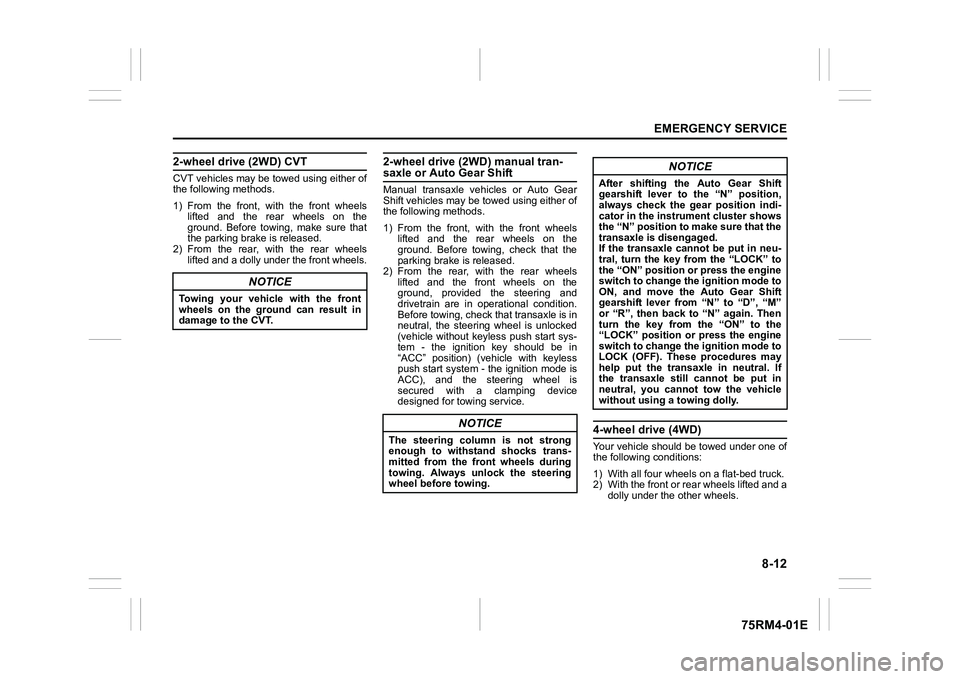
8-12
EMERGENCY SERVICE
75RM4-01E
2-wheel drive (2WD) CVTCVT vehicles may be towed using either of
the following methods.
1) From the front, with the front wheelslifted and the rear wheels on the
ground. Before towing, make sure that
the parking brak e is released.
2) From the rear, with the rear wheels
lifted and a dolly under the front wheels.
2-wheel drive (2WD) manual tran-saxle or Auto Gear ShiftManual transaxle vehicles or Auto Gear
Shift vehicles may be towed using either of
the following methods.
1) From the front, with the front wheelslifted and the rear wheels on the
ground. Before towing, check that the
parking brake is released.
2) From the rear, with the rear wheels
lifted and the front wheels on the
ground, provided the steering and
drivetrain are in operational condition.
Before towing, check that transaxle is in
neutral, the steering wheel is unlocked
(vehicle without keyl ess push start sys-
tem - the ignition key should be in
“ACC” position) (vehicle with keyless
push start system - the ignition mode is
ACC), and the steering wheel is
secured with a clamping device
designed for towing service.
4-wheel drive (4WD)Your vehicle should be towed under one of
the following conditions:
1) With all four wheels on a flat-bed truck.
2) With the front or rear wheels lifted and a dolly under the other wheels.
NOTICE
Towing your vehicle with the front
wheels on the ground can result in
damage to the CVT.
NOTICE
The steering column is not strong
enough to withstand shocks trans-
mitted from the fr ont wheels during
towing. Always unlock the steering
wheel before towing.
NOTICE
After shifting the Auto Gear Shift
gearshift lever to the “N” position,
always check the gear position indi-
cator in the instrument cluster shows
the “N” position to make sure that the
transaxle is disengaged.
If the transaxle cannot be put in neu-
tral, turn the key from the “LOCK” to
the “ON” position or press the engine
switch to change the ignition mode to
ON, and move the Auto Gear Shift
gearshift lever from “N” to “D”, “M”
or “R”, then back to “N” again. Then
turn the key from the “ON” to the
“LOCK” position or press the engine
switch to change the ignition mode to
LOCK (OFF). These procedures may
help put the transaxle in neutral. If
the transaxle still cannot be put in
neutral, you cannot tow the vehicle
without using a towing dolly.
Page 422 of 505
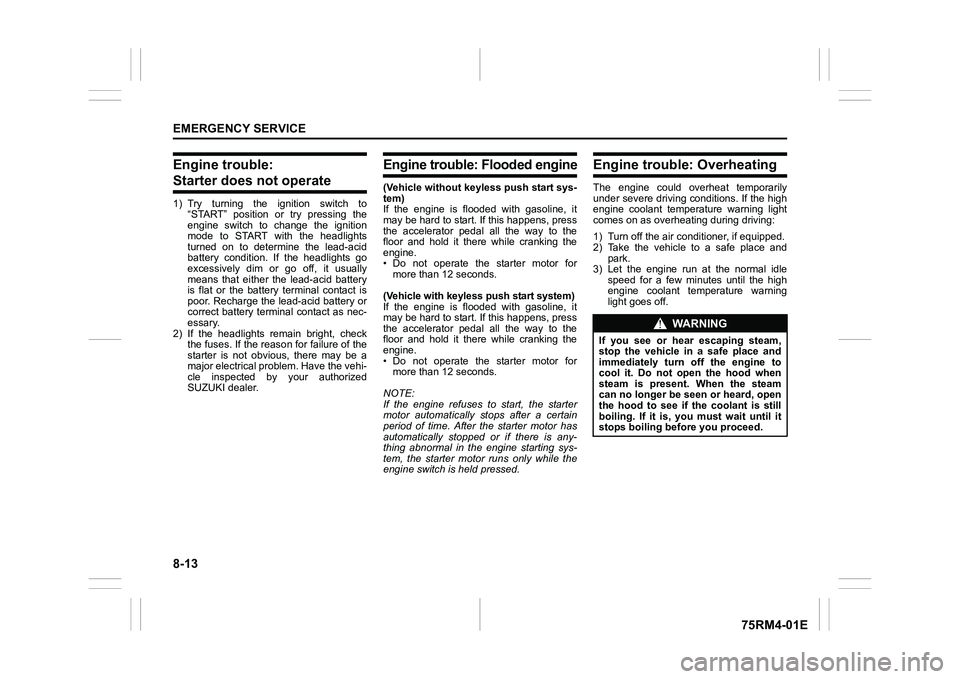
8-13EMERGENCY SERVICE
75RM4-01E
Engine trouble: Starter does not operate1) Try turning the ignition switch to“START” position or try pressing the
engine switch to change the ignition
mode to START with the headlights
turned on to determine the lead-acid
battery condition. If the headlights go
excessively dim or go off, it usually
means that either the lead-acid battery
is flat or the battery terminal contact is
poor. Recharge the lead-acid battery or
correct battery terminal contact as nec-
essary.
2) If the headlights remain bright, check the fuses. If the reas on for failure of the
starter is not obvious, there may be a
major electrical problem. Have the vehi-
cle inspected by your authorized
SUZUKI dealer.
Engine trouble: Flooded engine(Vehicle without keyless push start sys-
tem)
If the engine is flooded with gasoline, it
may be hard to start. If this happens, press
the accelerator pedal all the way to the
floor and hold it there while cranking the
engine.
• Do not operate the starter motor for more than 12 seconds.
(Vehicle with keyless push start system)
If the engine is flooded with gasoline, it
may be hard to start. If this happens, press
the accelerator pedal all the way to the
floor and hold it there while cranking the
engine.
• Do not operate the starter motor for more than 12 seconds.
NOTE:
If the engine refuses to start, the starter
motor automatically stops after a certain
period of time. After the starter motor has
automatically stopped or if there is any-
thing abnormal in the engine starting sys-
tem, the starter motor runs only while the
engine switch is held pressed.
Engine trouble: OverheatingThe engine could overheat temporarily
under severe driving conditions. If the high
engine coolant temperature warning light
comes on as overheating during driving:
1) Turn off the air conditioner, if equipped.
2) Take the vehicle to a safe place and park.
3) Let the engine run at the normal idle speed for a few minutes until the high
engine coolant temperature warning
light goes off.
WA R N I N G
If you see or hear escaping steam,
stop the vehicle in a safe place and
immediately turn off the engine to
cool it. Do not open the hood when
steam is present. When the steam
can no longer be seen or heard, open
the hood to see if the coolant is still
boiling. If it is, you must wait until it
stops boiling before you proceed.
Page 423 of 505
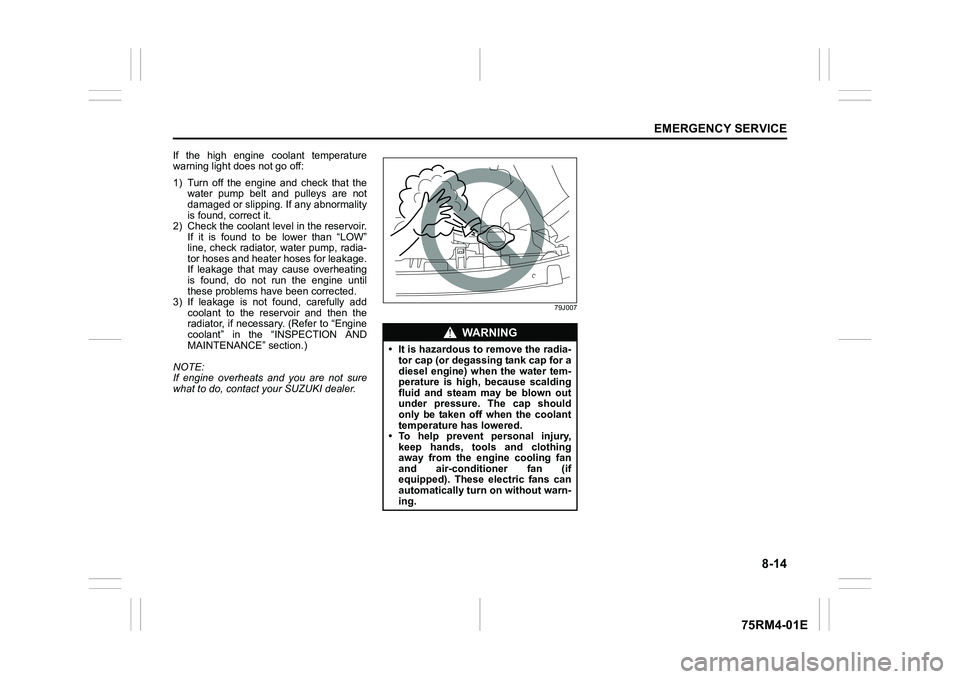
8-14
EMERGENCY SERVICE
75RM4-01E
If the high engine coolant temperature
warning light does not go off:
1) Turn off the engine and check that thewater pump belt and pulleys are not
damaged or slipping. If any abnormality
is found, correct it.
2) Check the coolant level in the reservoir. If it is found to be lower than “LOW”
line, check radiator, water pump, radia-
tor hoses and heater hoses for leakage.
If leakage that may cause overheating
is found, do not run the engine until
these problems have been corrected.
3) If leakage is not found, carefully add
coolant to the reservoir and then the
radiator, if necessary. (Refer to “Engine
coolant” in the “INSPECTION AND
MAINTENANCE” section.)
NOTE:
If engine overheats and you are not sure
what to do, contact your SUZUKI dealer.
79J007
WA R N I N G
• It is hazardous to remove the radia- tor cap (or degassing tank cap for a
diesel engine) when the water tem-
perature is high, because scalding
fluid and steam may be blown out
under pressure. The cap should
only be taken off when the coolant
temperature has lowered.
• To help prevent personal injury, keep hands, tools and clothing
away from the engine cooling fan
and air-conditioner fan (if
equipped). These electric fans can
automatically turn on without warn-
ing.
Page 424 of 505

8-15EMERGENCY SERVICE
75RM4-01E
MEMO
Page 425 of 505
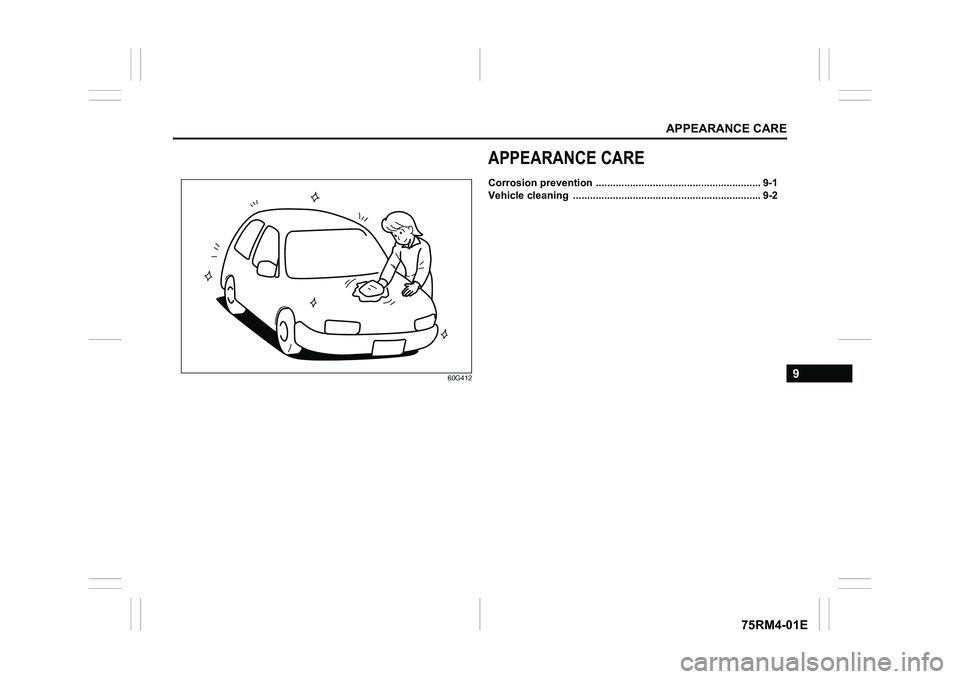
APPEARANCE CARE
9
75RM4-01E
60G412
APPEARANCE CARECorrosion prevention .......................................................... 9-1
Vehicle cleaning .............................................. .................... 9-2
Page 426 of 505
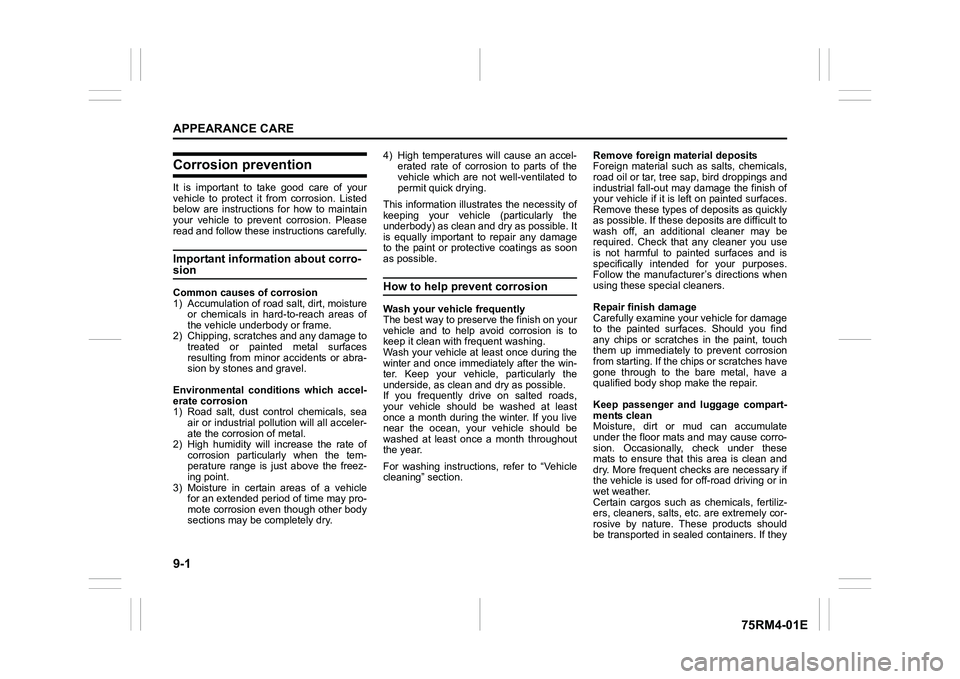
9-1APPEARANCE CARE
75RM4-01E
Corrosion preventionIt is important to take good care of your
vehicle to protect it from corrosion. Listed
below are instructions for how to maintain
your vehicle to prevent corrosion. Please
read and follow these instructions carefully.Important information about corro-sionCommon causes of corrosion
1) Accumulation of road salt, dirt, moisture or chemicals in hard-to-reach areas of
the vehicle und erbody or frame.
2) Chipping, scratches and any damage to treated or painted metal surfaces
resulting from minor accidents or abra-
sion by stones and gravel.
Environmental conditions which accel-
erate corrosion
1) Road salt, dust control chemicals, sea air or industrial pollution will all acceler-
ate the corrosion of metal.
2) High humidity will increase the rate of
corrosion particularly when the tem-
perature range is just above the freez-
ing point.
3) Moisture in certain areas of a vehicle for an extended period of time may pro-
mote corrosion even though other body
sections may be completely dry. 4) High temperatures will cause an accel-
erated rate of corrosion to parts of the
vehicle which are not well-ventilated to
permit quick drying.
This information illustrates the necessity of
keeping your vehicle (particularly the
underbody) as clean and dry as possible. It
is equally important to repair any damage
to the paint or protective coatings as soon
as possible.
How to help prevent corrosionWash your vehicle frequently
The best way to preserve the finish on your
vehicle and to help avoid corrosion is to
keep it clean with frequent washing.
Wash your vehicle at least once during the
winter and once immediately after the win-
ter. Keep your vehicle, particularly the
underside, as clean and dry as possible.
If you frequently drive on salted roads,
your vehicle should be washed at least
once a month during the winter. If you live
near the ocean, your vehicle should be
washed at least once a month throughout
the year.
For washing instructi ons, refer to “Vehicle
cleaning” section. Remove foreign ma
terial deposits
Foreign material such as salts, chemicals,
road oil or tar, tree sap, bird droppings and
industrial fall-out may damage the finish of
your vehicle if it is left on painted surfaces.
Remove these types of deposits as quickly
as possible. If these deposits are difficult to
wash off, an additional cleaner may be
required. Check that any cleaner you use
is not harmful to painted surfaces and is
specifically intended for your purposes.
Follow the manufacturer’s directions when
using these special cleaners.
Repair finish damage
Carefully examine your vehicle for damage
to the painted surfaces. Should you find
any chips or scratches in the paint, touch
them up immediately to prevent corrosion
from starting. If the chips or scratches have
gone through to the bare metal, have a
qualified body shop make the repair.
Keep passenger and luggage compart-
ments clean
Moisture, dirt or mud can accumulate
under the floor mats and may cause corro-
sion. Occasionally, check under these
mats to ensure that this area is clean and
dry. More frequent checks are necessary if
the vehicle is used for off-road driving or in
wet weather.
Certain cargos such as chemicals, fertiliz-
ers, cleaners, salts, etc. are extremely cor-
rosive by nature. These products should
be transported in sealed containers. If they
Page 427 of 505
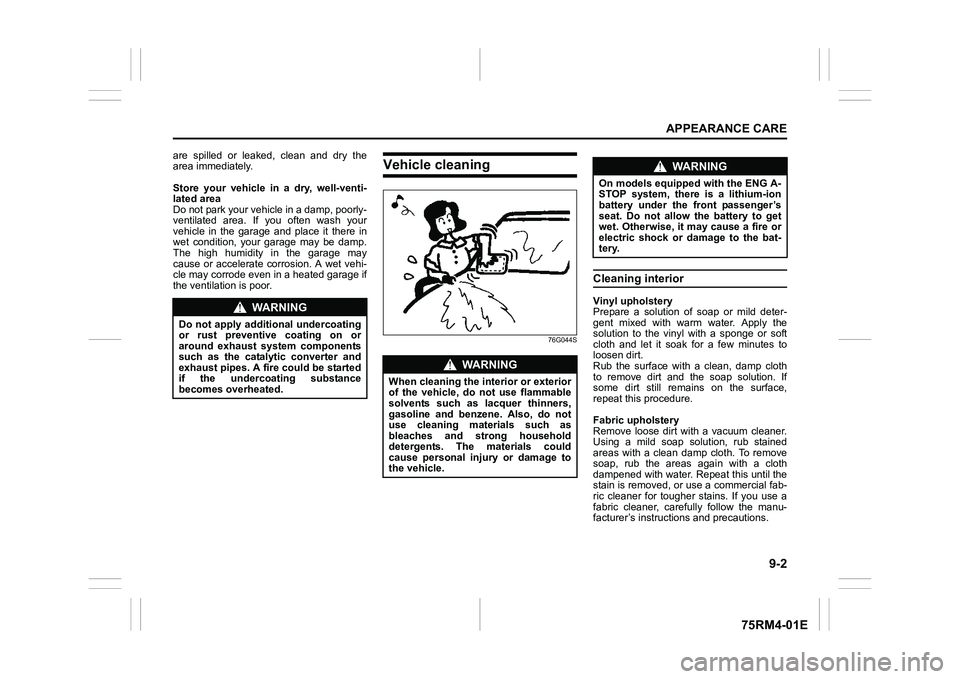
9-2
APPEARANCE CARE
75RM4-01E
are spilled or leaked, clean and dry the
area immediately.
Store your vehicle in a dry, well-venti-
lated area
Do not park your vehicle in a damp, poorly-
ventilated area. If you often wash your
vehicle in the garage and place it there in
wet condition, your garage may be damp.
The high humidity in the garage may
cause or accelerate corrosion. A wet vehi-
cle may corrode even in a heated garage if
the ventilation is poor.
Vehicle cleaning
76G044S
Cleaning interiorVinyl upholstery
Prepare a solution of soap or mild deter-
gent mixed with warm water. Apply the
solution to the vinyl with a sponge or soft
cloth and let it soak for a few minutes to
loosen dirt.
Rub the surface with a clean, damp cloth
to remove dirt and the soap solution. If
some dirt still remains on the surface,
repeat this procedure.
Fabric upholstery
Remove loose dirt with a vacuum cleaner.
Using a mild soap solution, rub stained
areas with a clean damp cloth. To remove
soap, rub the areas again with a cloth
dampened with water. Repeat this until the
stain is removed, or use a commercial fab-
ric cleaner for tougher stains. If you use a
fabric cleaner, carefully follow the manu-
facturer’s instructions and precautions.
WA R N I N G
Do not apply additional undercoating
or rust preventive coating on or
around exhaust system components
such as the catalytic converter and
exhaust pipes. A fire could be started
if the undercoating substance
becomes overheated.
WA R N I N G
When cleaning the interior or exterior
of the vehicle, do not use flammable
solvents such as lacquer thinners,
gasoline and benzene. Also, do not
use cleaning materials such as
bleaches and strong household
detergents. The materials could
cause personal injury or damage to
the vehicle.
WA R N I N G
On models equipped with the ENG A-
STOP system, there is a lithium-ion
battery under the front passenger’s
seat. Do not allow the battery to get
wet. Otherwise, it may cause a fire or
electric shock or damage to the bat-
tery.
Page 428 of 505
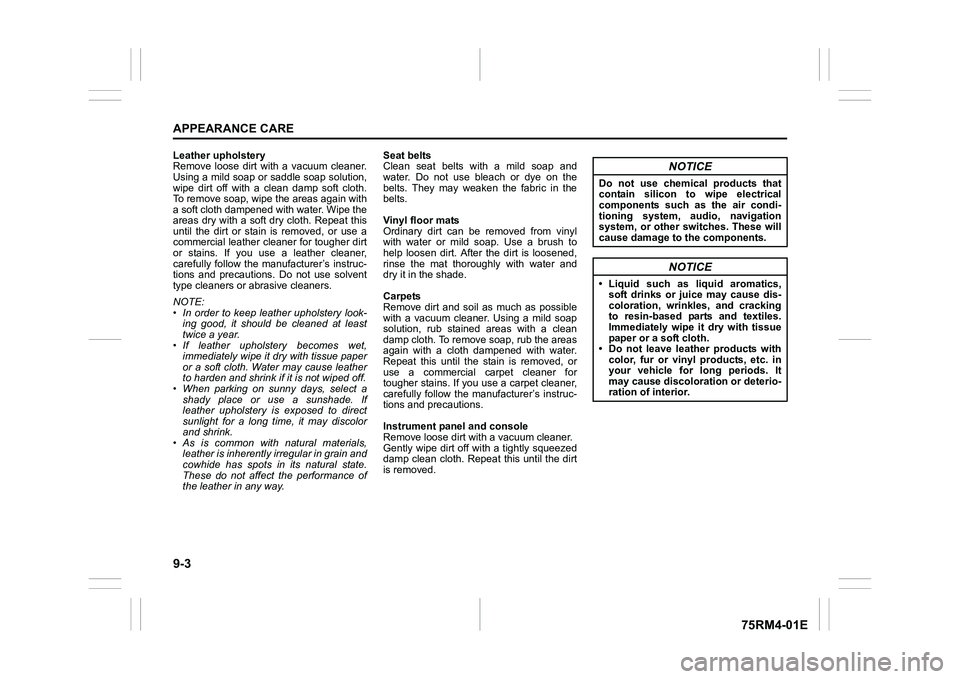
9-3APPEARANCE CARE
75RM4-01E
Leather upholstery
Remove loose dirt with a vacuum cleaner.
Using a mild soap or saddle soap solution,
wipe dirt off with a clean damp soft cloth.
To remove soap, wipe the areas again with
a soft cloth dampened with water. Wipe the
areas dry with a soft dry cloth. Repeat this
until the dirt or stain is removed, or use a
commercial leather cleaner for tougher dirt
or stains. If you use a leather cleaner,
carefully follow the manufacturer’s instruc-
tions and precautions. Do not use solvent
type cleaners or abrasive cleaners.
NOTE:
• In order to keep leather upholstery look-ing good, it should be cleaned at least
twice a year.
• If leather upholstery becomes wet, immediately wipe it dry with tissue paper
or a soft cloth. Water may cause leather
to harden and shrink if it is not wiped off.
• When parking on sunny days, select a
shady place or use a sunshade. If
leather upholstery is exposed to direct
sunlight for a long time, it may discolor
and shrink.
• As is common with natural materials, leather is inherently irregular in grain and
cowhide has spots in its natural state.
These do not affect the performance of
the leather in any way. Seat belts
Clean seat belts with a mild soap and
water. Do not use bleach or dye on the
belts. They may weaken the fabric in the
belts.
Vinyl floor mats
Ordinary dirt can be removed from vinyl
with water or mild soap. Use a brush to
help loosen dirt. After the dirt is loosened,
rinse the mat thoroughly with water and
dry it in the shade.
Carpets
Remove dirt and soil as much as possible
with a vacuum cleaner. Using a mild soap
solution, rub stained areas with a clean
damp cloth. To remove soap, rub the areas
again with a cloth dampened with water.
Repeat this until the stain is removed, or
use a commercial carpet cleaner for
tougher stains. If you use a carpet cleaner,
carefully follow the manufacturer’s instruc-
tions and precautions.
Instrument panel and console
Remove loose dirt with a vacuum cleaner.
Gently wipe dirt off with a tightly squeezed
damp clean cloth. Repeat this until the dirt
is removed.
NOTICE
Do not use chemical products that
contain silicon to wipe electrical
components such as the air condi-
tioning system, audio, navigation
system, or other switches. These will
cause damage to the components.
NOTICE
• Liquid such as liquid aromatics,
soft drinks or juice may cause dis-
coloration, wrinkles, and cracking
to resin-based parts and textiles.
Immediately wipe it dry with tissue
paper or a soft cloth.
• Do not leave leather products with color, fur or vinyl products, etc. in
your vehicle for long periods. It
may cause discoloration or deterio-
ration of interior.
Page 429 of 505

9-4
APPEARANCE CARE
75RM4-01E
Cleaning exteriorCaring for aluminum wheels
NOTE:
• Do not use an acidic or alkaline deter-gent, or a cleaner containing petroleum
solvent to wash aluminum wheels.
These types of cleaner will cause per-
manent spots, discoloration and cracks
on finished surfaces and damage to cen-
ter caps.
• Do not use a bristle brush and soap con-
taining an abrasive material. These will
damage finished surfaces.
WashingWashing by hand
60B212S
When washing the vehicle, park it in the
place where direct sunlight does not fall on
it and follow the in structions below:
1) Flush the underside of body and wheel housings with pressurized water to
remove mud and debris. Use plenty of
water.
2) Rinse the body to loosen the dirt. Remove dirt and mud from the body
exterior with running water. You may
use a soft sponge or brush. Do not use
hard materials which can scratch the
paint or plastic. Remember that the
headlight covers or lenses are made of
plastic in m any cases.
NOTICE
It is important that your vehicle be
kept clean and free from dirt. Failure
to keep your vehicle clean may result
in fading of the paint or corrosion to
various parts of th e vehicle body.
WA R N I N G
• Never attempt to wash and wax
your vehicle with the engine run-
ning.
• When cleaning the underside of the
body and fender, where there may
be sharp-edged parts, wear gloves
and a long-sleeved shirt to protect
your hands and arms from being
cut.
• After washing your vehicle, care-
fully test the brakes before driving
to check that they have maintained
their normal effectiveness.
NOTICE
When washing the vehicle:
• Avoid directing steam or hot waterof more than 80°C (176°F) on plas-
tic parts.
• To avoid damaging engine compo- nents, do not use pressurized
water in the engine compartment.
NOTICE
To avoid damage to the paint or plas-
tic surface, do not wipe the dirt off
without ample water. Follow the
above procedure.
Page 430 of 505
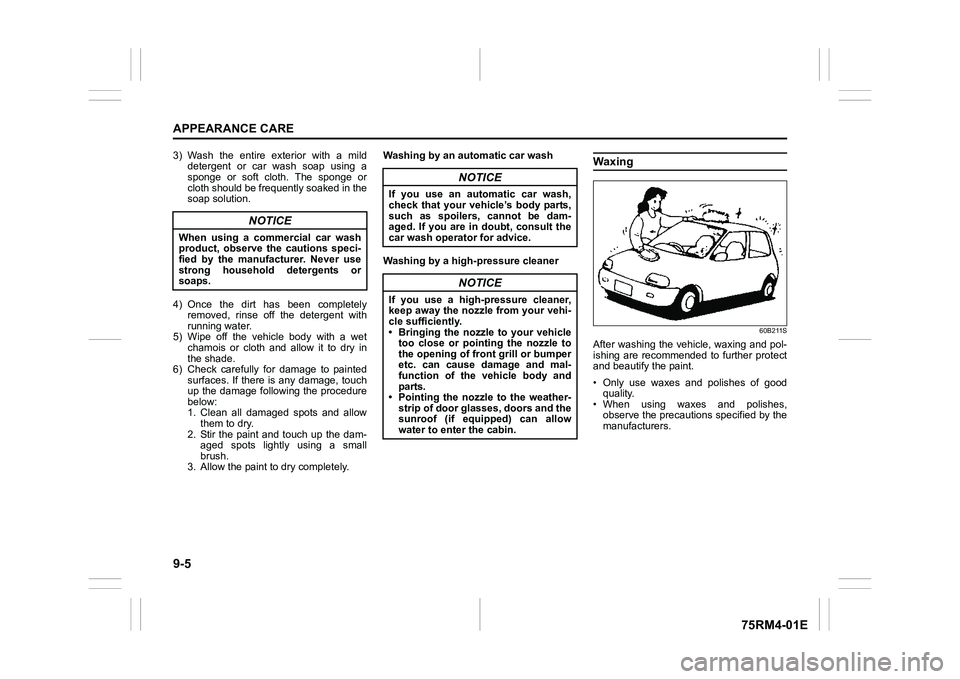
9-5APPEARANCE CARE
75RM4-01E
3) Wash the entire exterior with a milddetergent or car wash soap using a
sponge or soft cloth. The sponge or
cloth should be frequently soaked in the
soap solution.
4) Once the dirt has been completely removed, rinse off the detergent with
running water.
5) Wipe off the vehicle body with a wet chamois or cloth and allow it to dry in
the shade.
6) Check carefully for damage to painted surfaces. If there is any damage, touch
up the damage following the procedure
below:
1. Clean all damaged spots and allow
them to dry.
2. Stir the paint and touch up the dam- aged spots lightly using a small
brush.
3. Allow the paint to dry completely. Washing by an automatic car wash
Washing by a high-pressure cleaner
Waxing
60B211S
After washing the vehicle, waxing and pol-
ishing are recommended to further protect
and beautify the paint.
• Only use waxes and polishes of good
quality.
• When using waxes and polishes, observe the precautions specified by the
manufacturers.
NOTICE
When using a commercial car wash
product, observe the cautions speci-
fied by the manufacturer. Never use
strong household detergents or
soaps.
NOTICE
If you use an automatic car wash,
check that your vehicle’s body parts,
such as spoilers, cannot be dam-
aged. If you are in doubt, consult the
car wash operator for advice.
NOTICE
If you use a high-pressure cleaner,
keep away the nozzle from your vehi-
cle sufficiently.
• Bringing the nozzle to your vehicle
too close or pointing the nozzle to
the opening of front grill or bumper
etc. can cause damage and mal-
function of the vehicle body and
parts.
• Pointing the nozzle to the weather-
strip of door glasses, doors and the
sunroof (if equi pped) can allow
water to enter the cabin.